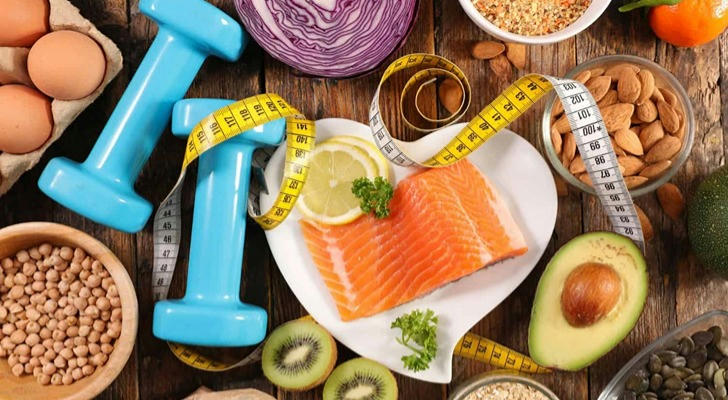What are the most popular weight loss methods in 2024?
Weight loss is crucial for enhancing overall health, reducing the risk of chronic diseases, and improving quality of life. It can lead to increased energy, better mobility, and greater self-esteem. However, individuals often face significant challenges, such as maintaining motivation, overcoming unhealthy eating habits, and managing stress. Understanding these obstacles and developing effective strategies can help achieve and sustain weight loss goals, paving the way for a healthier lifestyle.
Lose weight by controlling diet

•Low-carb diet: Reduce carbohydrate intake, control blood sugar content and hunger.
•Intermittent fasting: Control calorie intake and promote fat burning by adjusting eating and fasting times.
•Low-fat diet: Reduce fat intake, especially saturated fat, to help lose weight.
Liam is a 35-year-old man from the United States, 180 cm tall, and initially weighed 110 kg. Liam chose to lose weight by controlling his diet, making and following the following diet plan:
Breakfast
Oatmeal (cooked with water or low-fat milk) + a fruit (such as half a banana or a small bowl of berries) + a small handful of nuts (such as almonds or walnuts)
Lunch
Chicken salad (chicken breast, mixed green leafy vegetables, tomatoes, cucumbers, carrots) + a small portion of whole wheat bread (or a small bowl of brown rice)
Dinner
Grilled fish (such as salmon or cod) + steamed broccoli + a small portion of baked sweet potato (or a small bowl of whole wheat noodles)
After six months of persistence, Liam successfully lost 30 kilograms and his weight dropped to 80 kilograms. Not only did he feel physically lighter and more energetic, he also experienced greater confidence
Lose weight through exercise

•High-intensity interval training (HIIT): By alternating short periods of high-intensity exercise with low-intensity recovery, it can effectively increase metabolic rate and burn fat.
•Strength training: Strengthen muscles through weightlifting or resistance exercises, increase basal metabolic rate, and thus help to continuously burn calories.
•Aerobic exercise: such as running, swimming and cycling, which increase heart rate and calorie consumption, suitable for long-term persistence.
Below is a four-week exercise plan that is suitable for most beginners and intermediate exercisers
Monday-Sunday Exercise Plan
Monday: Full-body strength training
Warm-up: 5-10 minutes of brisk walking or jogging
Squats: 3 sets of 12-15 reps
Push-ups: 3 sets of 10-12 reps (knee push-ups can be performed as needed)
Dumbbell shoulder press: 3 sets of 12 reps
Dumbbell curls: 3 sets of 12 reps
Plank: 3 sets of 30 seconds each
Cool-down: 5 minutes of stretching (especially legs and back)
Tuesday: Aerobics
Warm-up: 5 minutes of slow walking
Main workout: 30 minutes of moderate-intensity aerobics (such as brisk walking, jogging, biking, or swimming)
Cool-down: 5 minutes of slow walking, stretching all muscles
Wednesday: Rest or light activity
Choose a light activity such as walking, yoga, or stretching exercises.
Thursday: Lower body strength training
Warm up: 5-10 minutes of brisk walking or jogging
Lunges: 3 sets of 12 reps (each leg)
Leg press: 3 sets of 15 reps
Glute bridges: 3 sets of 15 reps
Calf raises: 3 sets of 15 reps
Cool down: 5 minutes of stretching (especially legs and glutes)
Friday: Cardio
Warm up: 5 minutes of slow walking
Main workout: 30 minutes of high-intensity interval training (HIIT), e.g. 1 minute of high intensity (running or cycling) + 1 minute low intensity (walk slowly or rest), repeat 15-20 times
Cool down: 5 minutes slow walking, stretching muscles all over the body
Saturday: full body strength training
Warm up: 5-10 minutes brisk walking or jogging
Deadlift: 3 sets of 12 reps each
Pull-ups: 3 sets, as many as possible in each set (auxiliary tools can be used)
Bench press: 3 sets of 12 reps each
Side plank: 3 sets of 30 seconds per side
Cool down: 5 minutes stretching
Sunday: rest or light activity
Choose a light activity such as walking, yoga, or stretching exercises.
Injection for weight loss

• GLP-1 drugs: can increase satiety, reduce appetite, and help control blood sugar levels. These drugs are usually used under the guidance of a doctor and may take several months to work.
• Fat dissolving injections: This method promotes the breakdown and discharge of fat by injecting drugs directly into the fat layer. This method is suitable for localized fat reduction, but it usually takes multiple treatments to see significant results.
If you want to lose weight through injections, you can take a look at the general plan
1. Initial consultation:
• Comprehensive physical examination
• Blood test to assess metabolic health
• Discuss weight loss goals and expectations
• Review medical history and whether there are contraindications
2. Choose the type of injection:
• GLP-1 agonists: Such as Semaglutide or Liraglutide, help control appetite and improve blood sugar metabolism.
• Fat dissolving injections: May include a combination of amino acids and vitamins, designed to enhance fat metabolism.
• Decision: Choose the appropriate medication based on medical evaluation and patient preference.
3. Drug injection:
• Frequency: Usually once a week or daily injection, depending on the prescription.
• Method: Can be injected by the patient himself or by a professional in a medical institution.
• Dose: Determined according to the doctor's advice and adjusted according to individual needs.
4. Monitoring and adjustment:
• Weekly check: Regular follow-up to monitor progress, observe side effects, and adjust dosage as needed.
• Weight tracking: Weigh regularly to assess weight loss progress.
• Side effect management: Communicate with the doctor immediately if you encounter side effects or discomfort.
5. Lifestyle Adjustment:
• Diet: Eat a balanced diet and reduce calorie intake. Consult a dietitian to develop a diet plan.
• Exercise: At least 150 minutes of moderate intensity exercise or 75 minutes of vigorous intensity exercise per week.
• Behavioral Support: Participate in behavioral therapy or support groups to help develop healthy habits.
6. Long-term Maintenance:
• Continuous Monitoring: Regular follow-up visits to ensure long-term weight loss and overall health.
• Lifestyle Adherence: Maintain diet and exercise habits to support long-term weight management.
• Medication Adjustment: Adjust medications based on progress and changes in health status.
Weight loss methods include diet control, exercise, medication and surgery. When choosing a method, you should consider your personal health status and goals, consider your lifestyle, make a reasonable plan based on yourself, and regularly evaluate the results to ensure the continuity and effectiveness of the method, so as to achieve healthy and sustainable weight loss results.
